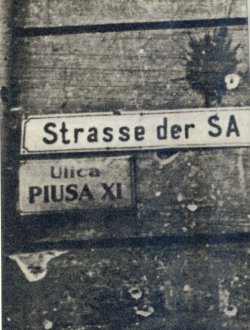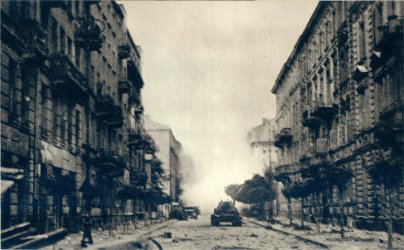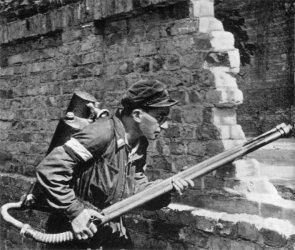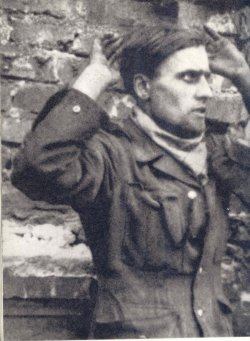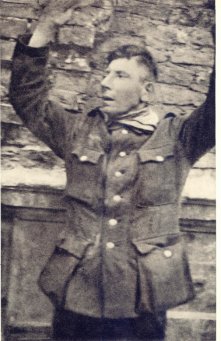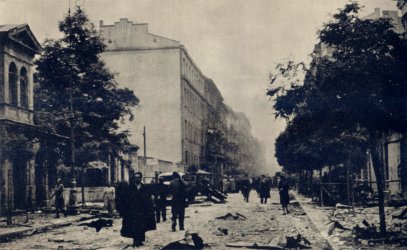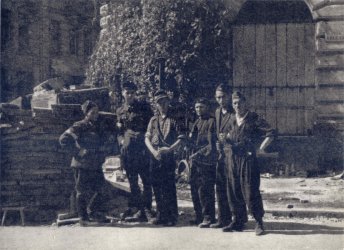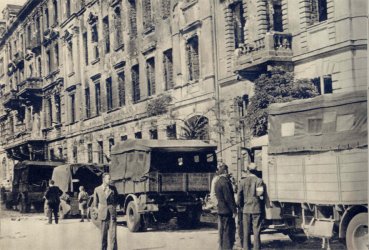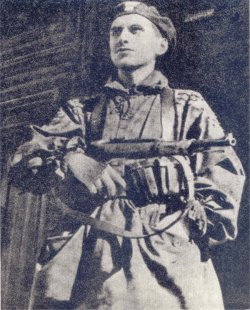"Little PAST" is a colloquial name for the property of the Office of Local Telephones, owned by the Polish Telephone Joint-Stock Company (Polska Akcyjna Spolka Telefoniczna - PAST). The building was located at 19 Piusa XI St. (now 19 Piekna St.) in the borough of Srodmiescie Poludniowe, Warsaw. The property comprised the main building and the back-premises surrounding the inner yard. These included:
- the eastern back-premise, next to the former German embassy at 17 Piusa XI St., burnt-out and pulled down in 1939. The premise housed a telephone exchange;
- the western back-premise. Its short wall was adjacent to the main building of "the Little PAST," while its long one, ending with a gable, adjoined a high building at 21 Piusa XI St., occupied by insurgents;
- the southern rear back-premise, together with a three meters high "boundary wall" closing the inner yard of "the Little PAST";
- the complex of additional buildings, including stables, garages and sheds. It is impossible today to give their exact locations.
In the corner of the southern back-premise there was a window - the location of the German outpost. The gable of that house adjoined a tall building with a partly destroyed blind wall, which belonged to the neighboring property on Koszykowa St., garrisoned by insurgents.
Time didn't take much toll on the main building of "the Little PAST." Watching it from Piusa St., it looked almost the same as today. On its left side there was a gateway leading to the yard, secured by a concrete bunker. The front door was on the right side. However, the neighboring building at 21 Piusa XI St. varied much from its present-day counterpart. Today, it forms a direct extension of the main building of "the Little PAST," with which it constitutes one entity. In 1944, though, the building was shorter, exposing part of the gable of "the Little PAST." This feature was the result of the damages made during German air raids in 1939. The edifice partly bordered the western back-premise. At that time Piusa St. was much narrower than today, with the facade of the building always hiding in the dark. For that reason it was difficult for insurgents to keep the Germans across the street under constant observation.
"The Little PAST" posed a serious threat to both insurgents and civil population. The machine gun of the German outpost covered not only Piusa XI St., but also parts of the following streets: Krucza, Mokotowska and Aleje Ujazdowskie. Despite being an isolated strong point, "the Little PAST" engaged a considerable force of insurgents as it was situated close to the German police district. The Gestapo headquarters located at Aleja Szucha (now the premises of the Polish Ministry of National Education) could always give a helping hand.
On 1 August 1944, when the Warsaw Uprising broke out, the fights also spread over the borough of Srodmiescie Poludniowe. The 24th Company under the command of Lt. Mieczyslaw Fajecki (a.k.a. "Kwiatkowski"), part of the 3rd Battalion W.S.O.P. of the Home Army "Narew," commanded by Capt. Zygmunt Netzer (a.k.a. "Kryska"), had been preparing an attack on "the Little PAST" since as far back as the spring of 1944. Before the assault, the Company had concentrated its forces at Z. Woloska Junior High School, located at 28 Piusa XI St. About 4.40 pm a group of approximately 20 German soldiers gathered near the gate of the Telephone Station building, listening to an increasing exchange of fire coming from the center of the city. At 5.00 pm sharp a few of the insurgents pelted the Germans with grenades. The Germans quickly retreated to the building; after a while they also dragged their two injured companions inside and barricaded the entrance. In the ensuing shooting sapper "Mazur" was lethally wounded. He died the next day. The following night the insurgents of the 3rd Platoon, armed with handguns, tried to reach the back of the "Little PAST" but, under the volley of bullets coming from the German machine gun, they were forced to retreat. From now on it was the VII Regiment "Ruczaj" that launched further assaults.
One of the units performing the next attack of 3 August was the covering company of 2. Region's commanding officer Rittmeister "Litwin," under the command of Capt. Stanisław Kulczycki (a.k.a. "Sas"). The soldiers, led by Lieut. Juliusz Loskoczynski (a.k.a. "Serafin"), used the breach in the western wall of the house to get inside, but the attack ended in failure. To make matters worse, around 8 am three German tanks made their way to the "Little PAST," boosting the confidence of German occupants. But the tank crews, hidden inside the steel shells of the vehicles, were caught by surprise when the squad led by Cpl. Cadet Jerzy Szuster (a.k.a. "Jur") showered them with grenades and Molotow cocktails. As a result, all three tanks burst into flames in the middle of Piusa XI St.
4 August marked the next attempt to capture the strategic point of "the Little PAST." One of the soldiers, Senior Rifleman Lech Czarnecki (a.k.a. "Lech"), was killed in action while trying to break into the building. Some German tanks again attempted to get near the house of "the Little PAST," but they were met with a fierce resistance of insurgents, who used grenades and Molotow cocktails to force the vehicles to pull back in the direction of Aleje Ujazdowskie.
On 5 August the Polish combatants made an effort to storm the telephone exchange once more. Capt. Zbigniew Lewandowski (a.k.a. "Iza"), a sapper from 2. Region, also took part in the struggle.
He recalls: "Thanks to a plastic bomb, I was able to make a breach in the flank wall of the house (on the side of the neighboring building) at the level of the third floor. We even managed to get into the building, but the Germans weren't caught off guard - they greeted us with grenades and submachine gun fire. A young officer cadet was killed on the spot. The blast of exploding grenades pushed me and the other two riflemen out of the building through the hole in the wall. They both got injured, but I was lucky and made it through with only severe bruising. We still tried to burn the building down - we threw some bottles with petrol through the breach, but the only things that burnt out in the room were the furnishings. The rest of the house didn't catch fire because its floor was concrete. Soon the Germans blocked off the breach again."
In total, five people lost their lives in this unsuccessful attack: four insurgents and a nurse called "Izabella," who was caught in the line of enemy fire. On 8 August the insurgents decided to try something else. According to a new plan, the attack was to be launched by making a hole in the roof of the building and then continuing through the attic to the very interior of "the Little PAST." The Polish soldiers gathered on top of the adjoining house, preparing a mine for detonation. But the Germans were very watchful; suddenly, they opened fire on the partisans. One of the bullets hit a detonator. A Polish sapper was torn to pieces in the resulting explosion. Another two Polish soldiers lost their lives. The next attack, launched on 10 August, was also unsuccessful: the only fruit it bore was the destruction of one of the bunkers situated in front of the building and a serious damage caused to the ground floor and third floor of the German "fortress."
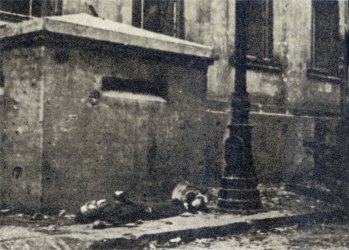
One of insurgents killed in action
On 5 August at around 10 am, the enemy soldiers from Aleje Szucha came to the rescue of the German crew surrounded by insurgents. The column, made up of 4 Panther tanks and a large number of German troops, set off from the Gestapo headquarters. The Germans used Polish women to protect the tanks. Some of them, organized in groups of 3-5 people, were sitting on the vehicles, while others were marching in mixed groups with German soldiers, many of whom wore ladies' scarves and coats for disguise. The women, used as a human shield, were picked up from the Gestapo prison on Aleje Szucha or were taken from the houses on Chocimska and Koszykowa St., where they were captured together with men, later executed by a firing squad.
Before the column set out, the German officer had informed the women that they were going to transport dead and injured soldiers from the telephone exchange back to the German side. The column's route began on Aleje Szucha, led through Aleje Ujazdowskie and then turned into Piusa XI St., near the fortified German positions. The convoy comprised 700 Polish women. It was so long that when the first women from the column approached the barricades near the houses no. 7-16 on Piusa XI St., the last ones hadn't even reached the street yet. Only two tanks, surrounded by this "human shield," drove into the street, keeping the distance of 40 meters from each other.
As soon as the commander of "Habdank" company from "Ruczaj" Regiment had been notified about the tanks' attack, he quickly got to Piusa XI St. and led the defense personally. Officer cadet Cpl. Jerzy Szuster ("Jur") positioned his squad on the second floor of one of the buildings across the street. Hardly had the German column approached the street than "Jur" started calling to women: "Run behind the barricades!" The females immediately rushed to escape and took shelter under the walls of the houses or behind the barricade, leaving the Germans in the middle of the street. The insurgents attacked the tanks at once, throwing grenades and Molotov cocktails in the vehicles' direction.
Soon the tanks opened heavy fire on the first and second floors of the buildings, right where the insurgents were hiding. Fortunately, the Germans decided against forcing the barricade: they pulled back approximately 30 meters away from it. The tanks were already on fire when they started retreating in the direction of Aleje Ujazdowskie, giving off a lot of smoke but still shooting back. Those of women who didn't get injured or were not killed during the escape were forced to pull back with the tanks. A few Germans, still disguised as women, took flight following the tanks.
Only two insurgents died in this attack, and two German tanks were damaged. The Panthers were able to escape thanks to self-activating fire-extinguishing devices that prevented their engines from catching fire.
On 10 August the Germans made another attempt to come to the rescue of their fellow soldiers on Piusa XI St. And again, despite the German bombardment of Srodmiescie Poludniowe that preceded the assault, the insurgents managed to repulse the attack of both infantry and tanks.
At the nighttime of 18 and 19 August the Germans made the last attempt to relieve the outpost at "the Little PAST." This time the German infantry advanced from Aleje Ujazdowskie towards Koszykowa, Chopin and Piusa XI St. in the hope of catching Polish combatants off guard. On Koszykowa St. they tried to take the defenders by storm, but each their attack was met with machine and handgun fire. The insurgents, hidden on upper floors and roofs of the buildings that flanked the street, bombed the attackers with grenades until they gave up and pulled back definitively. "The Little PAST," still surrounded by the insurgents, ended up as a trap for its German crew.
Since 5 August, the complex of "the Little PAST" had been besieged by about 60 insurgents, who were relatively poorly armed. They were patrolling the area of Piusa XI St. from Marszalkowska to Krucza St. and were keeping guard at the back of "the Little PAST" near Koszykowa St. and at the barricade at the junction of Piusa XI and Marszalkowska St. About 30 Polish soldiers occupied the area in front of "the Little PAST." As a result, there were not enough combatants to guard the entrance to each of the buildings situated along Piusa XI St. Taking advantage of this situation, the German soldiers tried to find a breach in the siege: they were leaving the outpost individually under cover of night to explore the area. Some of them approached the Polish positions carefully and, unexpectedly, threw grenades at the insurgents. Due to the lack of ammunition and grenades, the partisans had to abstain from responding with fire.
Today, Mieczyslaw Cwikowski describes the past struggle at "the Little PAST" in the following words: "I was trying to determine which way the Germans used to leave the building of "the Little PAST" and get into the street of Piusa XI, but I wasn't able to. One time the boys "treated" one of the Germans to a grenade, when he was wandering through the streets. He started crying while trying to get to the shelter, wailing "Ich bin krank." We spared his life, but it was so dark in front of the building that I couldn't see from across the street whether he entered the house through the gateway or the front door, or maybe using the rope ladder across the wall of the telephone exchange. This information might come in handy while planning the attack on the Little PAST."
Each floor of the building had been fortified by the Germans. The gateway had been blocked with trestles made of barbed wire. Near the gate there was a concrete bunker with sandbags for protection. Afraid that the insurgents might try to set fire to the building, the Germans decided to get rid of the furnishings from all of the front rooms and remove wooden frames and sills from the windows. The floor was covered with sand.
The insurgents had now three ways to attack "the Little PAST" - the front from Piusa XI St., the rear along the wall separating the inner yard from the property on Koszykowa St., and the west side, using the tenement house at 21 Piusa XI, which was garrisoned by insurgent troops. The date of the decisive attack on "the Little PAST" was scheduled for the night of 21 and 22 August. Capt. Franciszek Malik "Piorun" was assigned as the commander-in-chief of the offensive. The preparations took three days.
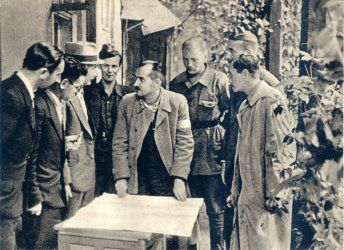
The staff of Sródmiescie 2. Region before the attack on "the Little PAST"
The following troops participated in the attack: the assault troop under the command of 2nd Lt. Tadeusz Kuliczkowski "Stojewicz," with the unit of sappers from the 3rd Company of V Regiment, commanded by 2nd Lt. Roman Rozalowski "Siekiera"; the assault troop of 2nd Lt. Wladyslaw Jarczewski "Nalecz" from "Habdank" Company; the assault troop commanded by 2nd Lt. Jozef Falandysz "Chmara" from "Lodecki" Company; the platoon of 2nd Lt. "Zbigniew" from "Tadeusz" Company; the platoon commanded by Staff Sergeant Cadet Wladysław Mikulski from "Kosma" Company, and the separated reserve from "Habdank" Company of 2nd Lt. Jerzy Grebski, supporting the unit of 2nd Lt. "Stojewicz." The 150th Platoon from 5th Company of "Golski" Armor Battalion, under the command of 2nd Lt. Henryk Rusinowski "Huragan," secured the barricade at the intersection of Piusa XI and Marszalkowska St. This unit was ordered to protect other attacking troops from this direction and possibly block the Germans if they decided to pull out this way. To sum up, the attack was to be performed by the troops from "Ruczaj" and "Golski" Battalions, and from V Regiment, commanded by Lt. "Siekiera."
The plan of the assault was as follows: the troops were to perform the frontal attack and were to flank the building from the west, using for this purpose the house at 21 Piusa XI St. Just before the assault, the sappers were to make breaches in the wall, creating a passage for the soldiers attacking from the west. The unit led by 2nd Lt. "Stojewicz" was to storm the top floor of the western back-premise of "the Little PAST," making use of the breach at the level of the attic. They were to be followed by the reserve of 2nd Lt. "Porecz." At the level of the first floor of the western back-premise the unit led by 2nd Lt. "Nalecz" was to attack the flank of the enemy that was hiding in the main building. Taking advantage of the confusion thus created, 2nd Lt. "Chmara" was to continue the assault by hitting the gateway from Piusa XI St. In case of failure, the front part of the building was to be sprinkled with benzine from a motor pump.
At the night of 21 and 22 August at 2.45 am, the storm units began to take their positions. Telephone lines and electrical wiring were cut on the roofs of the building. At 4.15 am the sappers detonated the explosives on the west side of the building, but the hole created in the corner of the roof was too small and the soldiers had to force their way through it one by one. The first to burst into the building was 2nd Lt. "Stojewicz," but he immediately got seriously wounded. The two soldiers who accompanied him were killed on the spot. The Germans covered the breach with the machine gun fire, in this way successfully blocking the entrance.
At the same time the unit led by 2nd Lt. "Nalecz" was performing the attack at the first floor level, trying to take advantage of the breach the size of 1.5 m. However, before the insurgents were able to clean up the entrance, the Germans showered them with grenades. But the Poles had another surprise up their sleeve. The sappers, hiding behind the walls, began to try to smoke the Germans out of the long corridor by means of flame-throwers.
Unfortunately, the weapons had a limited range of only about 50 m, and the fire went out quickly. When the Germans found out that the flame-throwers were not as effective, they immediately opened fire on the breach and on the insurgents, who responded with gun fire and Molotov cocktails. Eventually, the assault in this part of the building also ended in failure when the Germans blocked the gap with steel cabinets. At about 7 am the insurgents set fire to the western back-premise of "the Little PAST," which they did by means of flame-throwers and bottles with petrol. Another combatant, rifleman Jerzy Wozniak "Kaktus," lost his life in the ensuing exchange of fire. Consequently, the frontal assault never came into effect because of the flank attacks resulting in failure.
The insurgents put up a megaphone in front of the edifice. They made an appeal to the besieged, explaining in German that further resistance is pointless and coaxing them to surrender. Bursts of gunfire were the only answer.
Around 9 am Capt. "Piorun" gave an order to put the motor pump into action. The Germans, however, foiled its use. Firstly, it was a German marksman who shot through the motor pump's nozzle - a segment of a tube 3-4 cm in diameter. Shortly after, the soldier who operated the equipment was wounded in the head. No sooner did the insurgents repair the nozzle than it was again damaged by Germans. Having fixed the motor pump once more, the attackers were finally able to cover the walls of the main building with inflammable liquid.
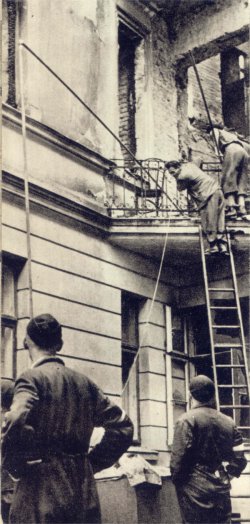
Applying benzine over the walls of "the Little PAST"
Being under constant fire, the insurgents were nonetheless able to throw some grenades and Molotov cocktails at the building from across the street, setting it to blazing fire. The building burst into flames and the fire started to consume upper floors of the house. However, it wasn't long before another bullet damaged the motor pump's nozzle. Once more the machine was out of order. Soon the fire went out, but the western back-premise was still ablaze. In spite of this, the insurgents couldn't make the Germans surrender. On the contrary, the enemy soldiers hung out a yellow flag symbolizing utmost danger, and spread the cloth with a swastika on the roof of the building. The sign was noticed by an enemy plane, which began to circle over the burning house.
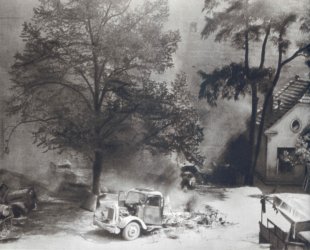
A burning car park at the back of the building
At 6 pm the German forces made another attempt at liberating the besieged crew of "the Little PAST." Squads of police and a Ukrainian company, supported by two tanks, attacked the streets of Chopin and Piusa XI, but the insurgents resisted the offensive. The German infantry, assisted by a Panther, also stormed Koszykowa St. until a well-aimed shot from PIAT (an anti-tank weapon), fired by Cadet Jerzy Przezdziecki "Rymwid," put the tank out of action. The infantry couldn't break through the grenade attack of insurgents and was forced to withdraw from the area. As a result of this battle, the Germans suffered heavy losses.
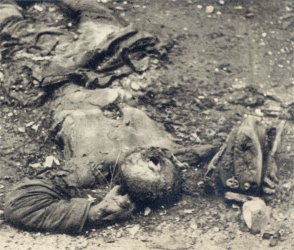
A military policeman, shot by insurgents; after his death he was run over by a German tank
In the evening of 22 August the German commander of "the Little PAST," SS officer Lt. Jung, entered into negotiations with Capt. "Piorun." He informed the insurgents that the German soldiers would stop fighting on condition that they were free to leave the building and depart at the Main Station, taking their weapons with them. Capt. "Piorun" stated that the insurgents would accept nothing less than unconditional surrender of the Germans. Consequently, the negotiations were broken off. Capt. "Piorun" scheduled the next attack for 23 August at 4 am, while the insurgents, under cover of night, arranged for yet another motor pump.
About 2.20 am the Germans began to sneak out of the building. Although it was dark and the rain had set in, the insurgents spotted the escape. One of the troops of "Ruczaj" Battalion under the command of Lt. "Zbigniew" burst into the building, taking 23 captives and liberating 22 hostages. The unit led by 2nd Lt. "Huragan" of "Golski" Battalion followed the attackers, storming the gateway of "the Little PAST."
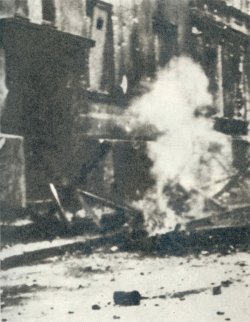
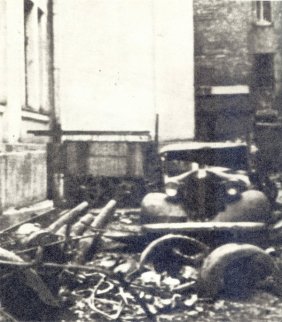
Struggle for "the Little PAST"
Another 5 German soldiers were taken prisoners and 5 Polish technicians, held as hostages, were freed as a result of the attack. The partisans also acquired 4 machine guns of "Zbrojowka" type, 10 rifles and a considerable amount of ammunition. The third attacking unit captured 11 Germans during their escape. Only one German was able to get away. In the early morning 2nd Lt. "Nalecz" and his patrol also entered the captured building. He examined the German defensive military posts, located upstairs in the attic.
Lying on the floor of the attic were the bodies of 2nd Lt. "Stojewicz" and his two soldiers. It seemed that "Stojewicz" must have been heavily wounded before his death, as there were strange-looking, lacerated wounds in his stomach. The only clothes he wore were his pants, covered with blood. Otherwise, his body was naked and barefoot. All the bodies were also robbed of personal possessions. 2nd Lt. "Nalecz" shrouded the bodies in sheets and went downstairs to the garages. There, lying in the ditches, were German corpses, covered with lime. Having searched the bodies the insurgents found a wallet belonging to 2nd Lt. "Stojewicz." The German soldier who had stolen the item, when later interrogated by the National Security Corps, admitted that just before his death "Stojewicz" had been tortured by Lt. Jung.
The Germans were fleeing "the Little PAST" in small groups. They could cross the barricade at the junction of Piusa XI and Krucza St. quite easily as it was not guarded by the insurgents due to its earlier bombardment.
Rifleman Jacek Szomanski "Bolesta" from the "Tadeusz" Company of "Ruczaj" Battalion recalls: "It was 1 pm when we took the guard over the barricade across Koszykowa St. at the corner of Mokotowska St. At our outpost there was a bunker built into the barricade, made of flagstones and sandbags (...). The bunker was equipped with a light machine gun (...). Moreover, we had two rifles: I had obtained one on Aleje Jerozolimskie and I had never parted with this weapon since then.
There were five of us keeping guard over the barricade. (...) It was just before dusk when a messenger woman gave us the password so we put up a sentry armed with a rifle outside the bunker to watch the area. Around 9 pm he stopped two insurgents heading in the direction of Savior's Square. (...) About an hour later, around 10 pm, the sentry spotted somebody approaching us from Piusa XI St. He called: "Stop! Who's there?" and received an answer: "Friends here!" - there had to be more of them coming. He told them to come closer and give the password. At the same moment we literally got under the rain of bullets coming from a machine gun somewhere on Chopin St. (...) I stood up quickly and started to fire my rifle at the incoming soldiers.
The Germans didn't run, however, but walked, the nearest of them being a few meters away from me. I shot him at the stomach but he was still able to take one or two steps forward before I shot him again, this time finishing him off. The others following him fell flat immediately. I hid in the bunker, positioning myself on the floor behind the sandbags forming a threshold there, and opened fire on the approaching enemy. (...) Lying behind the sandbags, I fired at everything that was moving either on Mokotowska St. or along the pavement opposite the bunker. Only one German soldier responded with fire - his bullet hit the beam in the ceiling of our bunker and the splinters injured my calves. (...) However, this way the German shooter revealed his position and I was able to take him out quickly." In total, 5 Germans were killed and 3 insurgents lost their lives in the shooting. For his bravery demonstrated on the battlefield, rifleman Jacek Szomanski "Bolesta" was awarded the Cross of Valor.
The first group of enemy soldiers trying to break through the siege snuck past the barricade near Krucza St. disguised as insurgents. One of them wore a white-and-red band around his helmet. It is very probable that the commander of "the Little PAST," SS officer Lt. Jung, also left the area in disguise. Other German groups tried to storm the barricade on Krucza St. by means of military force, covering themselves with machine gun fire and grenades. A few of them were shot down by the soldiers of "Poczta" Platoon, but others were able to fight their way through the barricade into Mokotowska, Chopin and Koszykowa St.
The rest of the German crew dispersed on a little square at the junction of Mokotowska, Krucza and Piusa XI St. Taking advantage of the nighttime, they attempted to find the ways of further escape, but the platoon commanded by 2nd Lt. Jerzy Gebski "Porecz" encircled the Germans and, after a short fight, forced them to capitulate. During the fight and chase, the insurgents tracked down other groups of enemy soldiers. Eight of them were trying their luck to get to Savior's Square. Two of the escapees were shot by Sgt. "Szkapa" from "Lodecki" Company of "Ruczaj" Battalion, but in the process he got seriously wounded in the neck. The remaining six Germans crossed the barricade, however, and made it to the German post on Savior's Square.
According to the testimony given by German POWs, on 1 August there were only 75 post clerks at "the Little PAST." Once the uprising broke out, 8 non-commissioned officers and 1 Wehrmacht officer arrived at the building, while on the night of 1 and 2 August there came additional 32 privates and 1 SS officer. To sum up, the crew of "the Little PAST" amounted to 117 German soldiers. They were armed with 180 rifles and sub-machine guns, 250 hand-grenades, 4 Panzerfausts and 1 rocket launcher. According to different sources and accounts, about 65-76 Germans were taken captive, 18-21 were killed, while 15, including the commander Lt. Jung, broke through the siege and reached German posts.
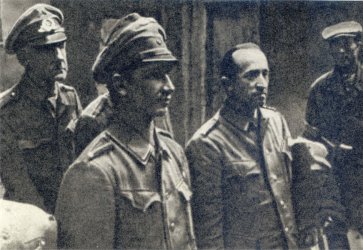
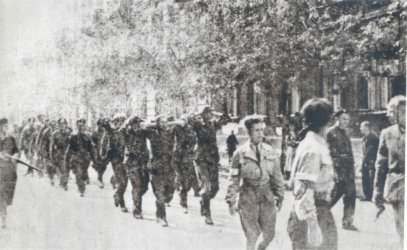
German POWs taken captive during the struggle for "the Little PAST"
The Polish troops lost 25 insurgents.
After many days of heavy struggle, the insurgents' efforts were rewarded with a glorious victory - capturing the German strong point.
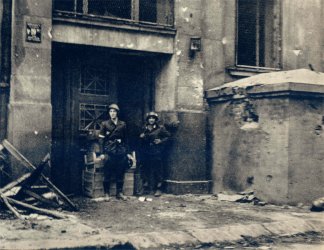
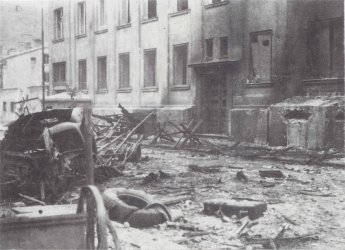
In front of the captured building The ravages of war
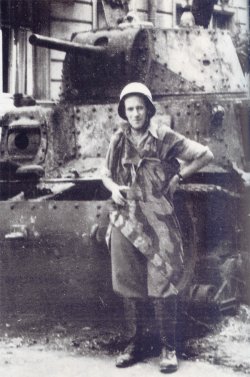
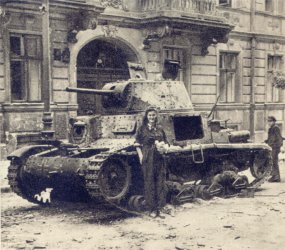
A German tank destroyed during the fight (Fiat M14/41 made in Italy)
Capt. Franciszek Malik "Piorun", the commander of the Polish forces, was awarded the Order Virtuti Militari of V class, while 2nd Lt. Eng. Michał Tadeusz Slominski "Tadeusz Czarny" received the Cross of Valor and the Order Virtuti Militari of V class. In addition to this, many soldiers from "Ruczaj" Battalion were awarded according to their deeds and achievements, e.g. 2nd Lt. "Nalecz." The building of "the Little PAST" has survived the ravages of the warfare in quite a good condition. This was not the case of the PAST building on Zielna St., however, which was almost completely burnt out.
After the evacuation of the Home Army High Command from the borough of Srodmiescie, the building of "the Little PAST" had acted as its headquarters until the very end of the Warsaw Uprising. During the insurgency, the Home Army High Command often changed the location of its command center. As the war progressed, it was based in:
1 - 6 August, Kamler's factory at the corner of Okopowa i Dzielna St., Wola district
6 - 13 August, the school located at 6 Barokowa St., Warsaw's Old Town
13 - 25 August, the Ministry of Justice courthouse, 7 Dluga St., Warsaw's Old Town
26 August - 5 September, PKO building on Swietokrzyska St., on the corner of Jasna St., Srodmiescie Polnocne
since 6 September 1944, the building of "the Little PAST" at 17 Piusa XI St., Srodmiescie Poludniowe.
Today, the telephone exchange in the Little PAST is still operating. A commemorative plaque, devoted to the insurgents and their efforts to capture the building, has been built into the wall.
compiled by: Adam Rozmysłowicz
edited by: Maciej Janaszek-Seydlitz
translated by: Beata Murzyn
Copyright © 2009 SPPW1944. All rights reserved.
